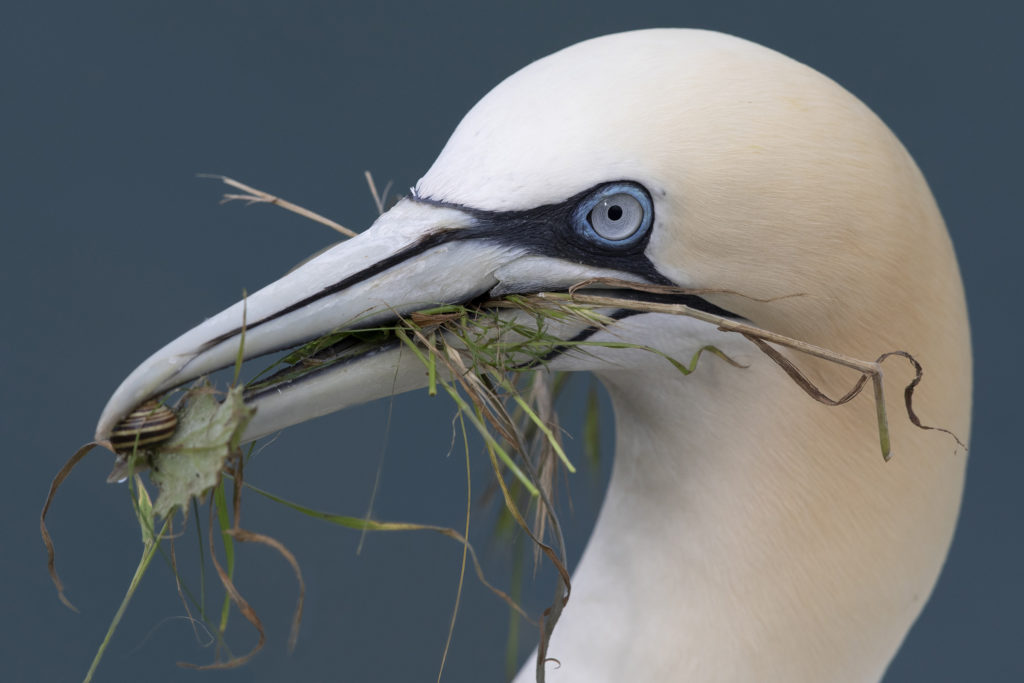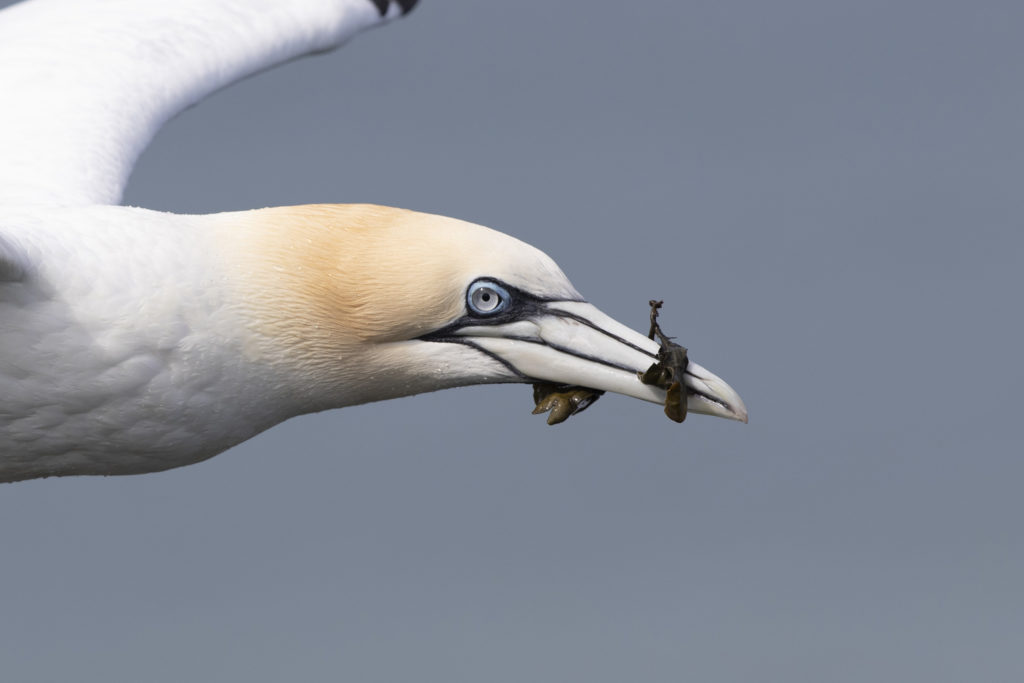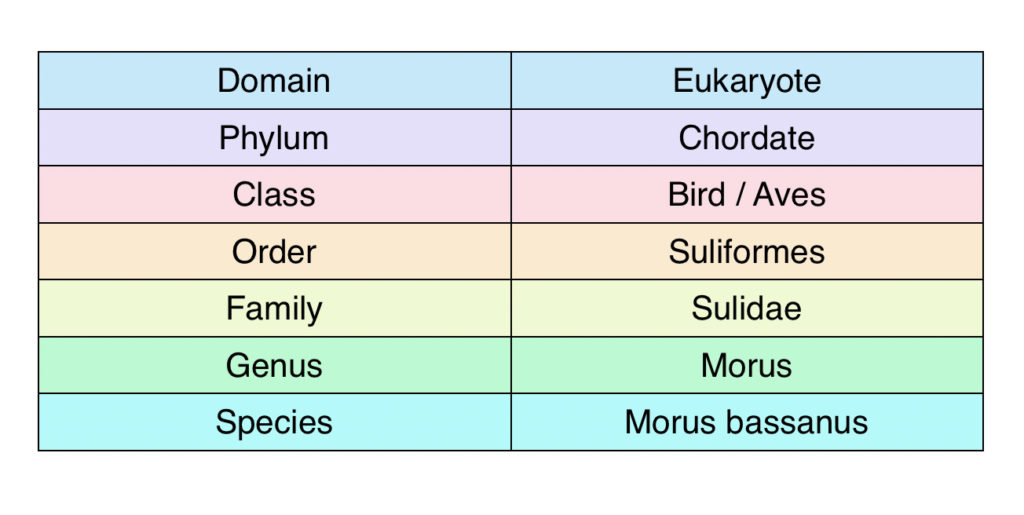Northern Gannet, Scientific Name: Morus bassanus

Size:
The northern gannet has a wingspan of approximately 165 – 180cm.
Description:
The first thing to notice about the northern gannet is its size. It’s the largest of our seabirds in the UK and is hard to miss! The adult appears primarily white, however the strong black wingtips are often obvious, even at a distance. Closer to the bird, you will see the subtle yellow colour of its head and the blue ring around its eye as well. It also has black markings lining its face and bill. The gannet’s bill is very long, strong and sharp, adding to the bird’s distinctive look.
The overall colour of younger birds is dependent on their age and they can range from very dark to white with speckled brown patches. However, they still have the noticeably gannet-like overall appearance with their hefty wings and long bill.

Identifying Sex:
At first glance it is not necessarily possible to identify a male northern gannet from a female, although size or colouration may occasionally lead to accurate placing.
Using behaviour to identify sex can be more reliable although is not watertight. For example, males primarily collect nesting material, however females also occasionally perform this action.
Whilst you cannot be 100% sure of the sex from a distance, becoming familiar with the birds may allow you to make an educated guess that a bird is more likely to be a male than a female and vice versa.
Diet:
The northern gannet is known for its spectacular diving ability. It achieves a deeper dive by starting high over the water and pulling its wings into its body moments before impact. Whilst the dive itself is impressive, the bird struggles to become airborne again.
The risks attached to diving in this way are reduced by the gannet’s evolutionary adaptations such as membranes over its eyes, internal nostrils and pockets of air protecting its neck and head from the impact of the water.
This striking way of hunting looks exciting, but is, at the end of the day, a means to an end. If the gannet is lucky, the result is a fish about the size of herring or mackerel.
The Breeding Season:
Come January, male gannets are starting to return to their breeding colonies in order to make preparations for the oncoming season. They often return to the same nest each year and mate with the same female. gannets don’t begin to breed until they’re 4 years old and so in the meantime they observe the adult birds at work.
The younger birds may try making their own nest or even take over a deserted nest if there’s no bird around to defend it. The nest has to be constantly repaired though, which is done with a variety of materials. Seaweed is an obvious choice, although gannets will use whatever they can find. Sadly this includes plastics that can and do have a catastrophic effect on chicks.
Despite living within such close proximity to each other, these birds are very territorial. They will often fend off gannets of the same sex with a violent poke from their sharp bill. On the flip side, gannets are also renowned for their seemingly romantic mating dance. It’s important for coupled birds to maintain a close bond as the breeding season begins. Therefore they perform a display of tilting heads and tapping bills that enthrals spectators.

New Life:
The female gannet lays a single egg around late April to mid June. Both parents incubate the egg over the course of 44 days, until it hatches. The chick that emerges is then fed on regurgitated fish. Approximately ninety days later, the parents withdraw from feeding their youngster in order to prompt it to make its own way in the world.
The chick doesn’t leave the nest immediately, but instead takes around ten days to lose some weight and build strength in its wings ready for take-off. Its excess fat helps the chick in its early weeks of independence before it begins feeding itself.
If gannets are both lucky and successful in their survival, they can live into their thirties.
On a Personal Note:
We have had the good fortune to see a range of northern gannets in different locations across the UK including Pembrokeshire, Bempton Cliffs, Bass Rock and St Kilda. Each of these locations has offered a unique experience.
We had our closest encounter on Bass Rock, which allowed us the opportunity to see gannets at the nest. It is not difficult to identify gannets once you’ve seen them and so you can soon relax and enjoy watching their behaviour.
Northern gannets are not against stealing or acting violently. They’re incredibly entertaining at the nest as both of these actions happen regularly. They often steal nesting material from other gannets. Meanwhile the victim may be baffled by their magically reducing nest or perhaps they’ll catch the thief red-handed. The latter often results in aggressive squawking and attempted poking with its dauntingly sharp bill.
On the flip side, romance at the nest is not uncommon either. One of the highlights of watching gannets is seeing their elegant mating ‘dance’.
All in all, a gannet colony is a lively place to be with exciting behaviour happening left, right and centre. If you have not yet had the good fortune of watching gannets, head out to the coast during the breeding season. Check out our useful links below for good locations.
Northern Gannet Taxonomy:

Useful Links:
To head out and see gannets at the RSPB site at Bempton Cliffs, click this link to plan your visit.
To find out more about seeing gannets on the St Kilda archipelago, Scotland, click this link.
Comments:
We love to know your thoughts on our articles so greatly appreciate you taking the time to comment. We may be unable to reply directly but are in the process of creating a FAQs page to answer any questions. All comments are currently checked before they’re posted so they do not appear immediately on the website.
Thank you for visiting www.embracenatureuk.com!
